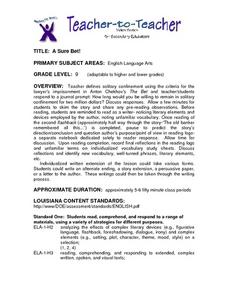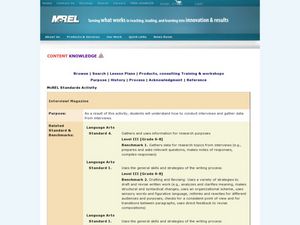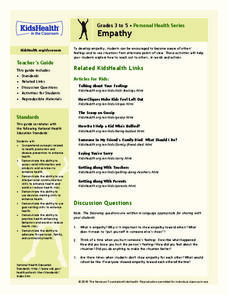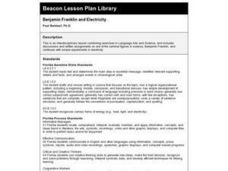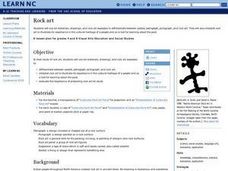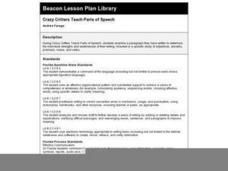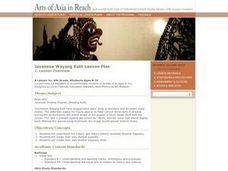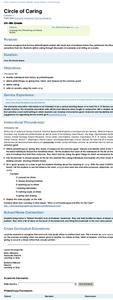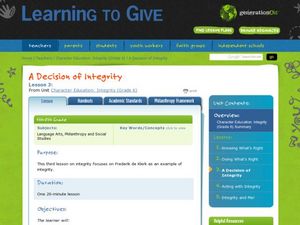Curated OER
PICTURE ID
Students name or label some pictures of important people and events from areas where the target language is spoken. They study prominent people in history and identify individual pictures of prominent people from the target culture(s)....
Curated OER
Does Word Choice Affect the Quality of a Piece of Writing?
Students discuss the importance of word choice in writing. In groups, they rank a list of words from one extreme to the other. After viewing an example, students apply their knowledge of word choice by writing a descriptive paragraph of...
Curated OER
A Sure Bet!
Ninth graders analyze Chekhov's "The Bet". They repsond to a journal quesiton and use examples from the novel. In groups, they take on different roles analyzing the novel and then write one of my prompts to complete the lesson.
Curated OER
What Difference Does A Name Make?
Students view the film The Persuaders that discuss the perspective and spin of language use for a variety of issues. They discuss the career of Frank Luntz, a man that runs focus groups to determine how to advantageously phrase issues in...
Curated OER
Nursery Rhymes
Young scholars recall details of nursery rhyme read by teacher, identify main characters, and demonstrate knowledge of poem by creating concept map about story that includes title, clip art, and changes in font and color.
Curated OER
Valentine Cinquain
Students review parts of speech by using Inspiration. They brainstorm vocabulary that fit a Valentines theme. Students watch as the teacher demonstrates the parts of a cinquain poem. Students write their own poem and create a KidPix...
Curated OER
Courage comes in all sizes: King Day
Third graders create a cinquain poem in groups about philanthropy and heroes. In this heroes lesson plan, 3rd graders review characteristics of heroes and how they demonstrate justice, kindness, and contribute to the common good. Then...
Curated OER
Interview! Magazine
Students interview a subject and write a biographical sketch for a fictional magazine. In this interview lesson, students choose a person to interview and create two sets of questions. Students conduct the interview. Students then write...
Curated OER
Empathy
Students complete activities to develop empathy. In this empathy instructional activity, students complete discussion activities and all the related worksheets in order to build their understanding of the concepts to empathy. Students...
Curated OER
What is American Culture
Students create what they feel is American Culture using a video camera and capturing 5 frames. They are animating parts of a poem in small groups. They decide the set up, create movable figures, and have a music section. Each person...
Orange County Department of Education
Dear Mr. Henshaw
Fifth graders read Dear Mr. Henshaw and identify the character trait of self-respect as exhibited by Leigh throughout the story. They evaluate the author's use of letters to tell the story and discuss how the story would be different if...
Curated OER
Voices of Tragedy and Horror: Remembering the Holocaust
Students consider the implications of the Holocaust. For this World War II lesson, students read the graphic novel Maus at the end of a unit on World War II. Students discuss the impact of reading about the Holocaust as well as theme of...
Curated OER
Pictures in Words: Poems of Tennyson and Noyes
Eleventh graders describe and analyze the effects of poetry on readers. They participate in an Internet scavenger hunt, an exercise involving interpretation of poetry through visual art, and an opportunity for students to create their...
Curated OER
Benjamin Franklin and Electricity
Second graders study Benjamin Franklin and participate in simple experiments in electricity.
Curated OER
List Poetry
First graders create a list poem using the letters of their names. They describe themselves in the poems, present them and publish a class poetry book.
Curated OER
Comparing Characters Across Two Short Stories
Ninth graders listen to a read aloud of two short stories focusing on literary devices. The write about the settings and realism of the stories, and decide each main character handles the conflict he faces with nature.
Curated OER
Rock art
Students study rock art they use art materials, colored photographs and rock art examples to: differentiate between symbol, petroglyph, pictograph, and rock art. They interpret rock art to illustrate its importance in the cultural...
Curated OER
Dialogue Tags/ Synonyms for Said
Sixth graders analyze dialogue tags. In this synonyms lesson students work in groups analyzing a personal narrative. They enter the words onto a classroom chart as well as their notes or journal. The students replace tags with more...
Curated OER
Crazy Critters Teach Parts of Speech
Students create pieces of writing about a creature they have created. They examine the parts of speech and how they are used in their writing to see how they can write more specifically.
Curated OER
Most Wanted Villians
Pupils review the characteristics of various characters in fairytales. As a class, they review the story details and create a concept map using a software program. They create their own wanted poster of the villians in the fairytale to...
Curated OER
New Kids on the Block
Second graders identify and describe in their own language, the following 2-dimensional and 3-dimensional shapes: triangle, square, oblong (non-square rectangle), circle, oval, pentagon, hexagon, diamond, box, cylinder, and sphere. They...
Curated OER
Javanese Wayang Kulit Lesson Plan
Fourth graders study the history and culture associated with Javanese Shadow Puppets and the perspective that is used during performances. They design original shadow puppets and give a shadow puppet performance using their creations.
Curated OER
Circle of Caring
Middle schoolers explore the concept of philanthropy. In this service learning lesson, students study the works of well-known philanthropists and write an acrostic poem using the word CARING.
Curated OER
A Decision of Integrity
Middle schoolers study a man's life. In this values lesson, students read about Frederik De Klerk and answer discussion questions. Middle schoolers discuss his values, especially integrity, and how they made a difference.




